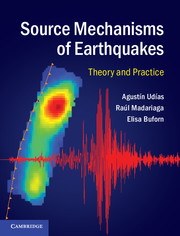Book contents
- Frontmatter
- Contents
- Preface
- Chapter 1 Earthquakes and fault motion
- Chapter 2 Processing and analysis of recorded seismic signals
- Chapter 3 Mathematical representation of the source
- Chapter 4 Point source models
- Chapter 5 The seismic moment tensor
- Chapter 6 Determination of point source mechanisms
- Chapter 7 Kinematics of extended sources
- Chapter 8 Determination of source dimensions
- Chapter 9 Simple dynamic models
- Chapter 10 Dynamics of fracture. Homogeneous models
- Chapter 11 Fracture dynamics. Heterogeneous models
- Chapter 12 Modeling earthquakes using fracture dynamics
- References
- Index
Chapter 1 - Earthquakes and fault motion
Published online by Cambridge University Press: 05 June 2014
- Frontmatter
- Contents
- Preface
- Chapter 1 Earthquakes and fault motion
- Chapter 2 Processing and analysis of recorded seismic signals
- Chapter 3 Mathematical representation of the source
- Chapter 4 Point source models
- Chapter 5 The seismic moment tensor
- Chapter 6 Determination of point source mechanisms
- Chapter 7 Kinematics of extended sources
- Chapter 8 Determination of source dimensions
- Chapter 9 Simple dynamic models
- Chapter 10 Dynamics of fracture. Homogeneous models
- Chapter 11 Fracture dynamics. Heterogeneous models
- Chapter 12 Modeling earthquakes using fracture dynamics
- References
- Index
Summary
The origin of earthquakes
Humankind's experience of earthquakes has always given rise to shock and confusion. The ground beneath us, our basis of stability, is suddenly subject to shaking, bringing ruin to buildings and causing high numbers of casualties. Investigating the causes of these phenomena has interested human beings since antiquity. The first rational explanations, beyond mythical stories, were presented by Greek natural philosophers beginning in the sixth century BC. The most lasting theory of the Greek philosophers was presented by Aristotle (fourth century BC) in his book Meteorologica. By the word meteors ancient Greeks referred to a variety of phenomena which were believed to take place somewhere above the Earth's surface, such as rain, wind, thunder, lightning, comets and the Milky Way, or inside the Earth, such as earthquakes and volcanoes. Aristotle refuted the ideas proposed by previous authors, as Anaxagoras, Empedocles and Democritus, and proposed that the cause of earthquakes consisted in the shaking of the Earth by dry heated underground exhalations or winds trapped in cavities of its interior, as they attempt to escape toward the exterior. This explanation was part of his general theory for “meteors”, which, he proposed, were all caused by various types of exhalation of dry or humid, cold or hot, vapors or winds, which extended from the interior of the Earth to the Lunar orbit. This was a very popular theory, which was accepted with only minor changes until the seventeenth century. Roman authors such as Pliny and Seneca presented it in their encyclopedic works and medieval authors such as Albert the Great and Thomas Aquinas wrote long commentaries on it.
The general reaction against Aristotelian physics, and the birth of modern science in the seventeenth century, gave rise to a new theory to explain the origin of earthquakes. Martin Lister in England and Nicolas Lemery in France proposed that earthquakes were caused by spontaneous explosions of flammable material accumulated underground in certain regions. The increasing use of mines in mining and military operations suggested this idea. The explosive theory was supported by Newton and Buffon and helped to define the concept of the focus of an earthquake as the location where the explosion took place.
- Type
- Chapter
- Information
- Source Mechanisms of EarthquakesTheory and Practice, pp. 1 - 21Publisher: Cambridge University PressPrint publication year: 2014



